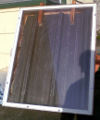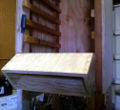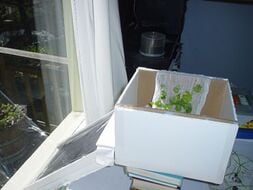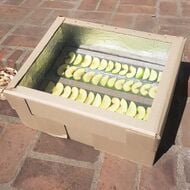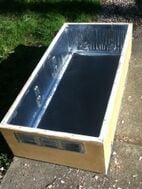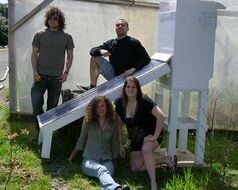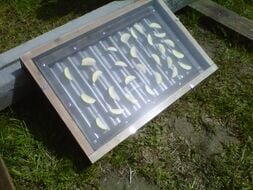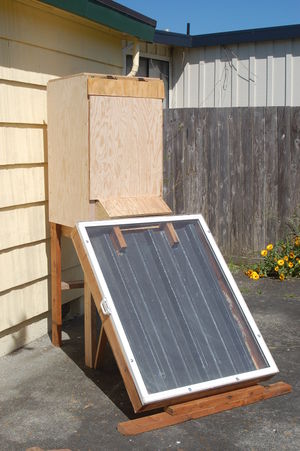
The purpose of building a solar dehydrator is to provide the Arcata Educational Farm with a reliable hybrid dehydrator. Its goal is to help preserve surplus crops. In addition to using this dehydrator as an alternative method in preserving vegetable, fruits, and meat, it will promote sustainable practices.
This solar dehydrator will not only serve as a tool for preserving and storing foods, it will also be a demonstration. This display is designed for the farmers, share holders, and communities members so that they may witness and apply sustainable and alternative technology to their everyday lives.
Unlike the electric dehydrator, this solar dehydrator will draw its energy from harnessing the sun, eliminating the need for electricity. Because of their simplicity and low material cost, solar dehydrators provide the ability to dehydrate and preserve food to anyone.
Introduction[edit | edit source]
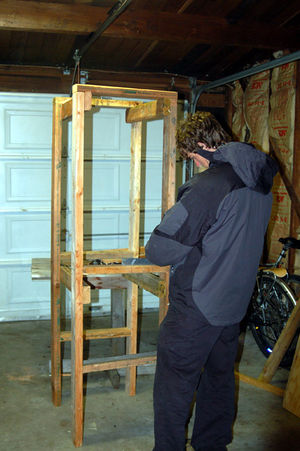
Solar dehydration is a great example of appropriate technology. This alternative method allows for the direct use of sun's energy to preserve food, which is key to the livelihoods of people all over the world. This technology has multiple designs which often use less material and are more energy efficient and cost efficient than conventional electrical methods.
Dehydrating food has been a long standing practice of cultures all over the world. With many cultures dehydrating food by placing it on roof tops or on the ground to dry. This unfortunately has the high risk of contamination from dirt, pests, and unfavorable weather. By creating a dehydrator which has a covering it is less likely that the food will be exposed to contaminants.
The principle behind dehydrating is taking out the excess water in the fruit, vegetable, or meat, as a means of preserving and storing. By taking out the water content it limits the medium that harbors bacteria or fungi. Dehydrating food allows it to have a storage life of multiple years.
Solar dehydrators work by creating a consistent warm air flow through a cabinet containing the agricultural products on various shelves. Solar energy is absorbed in a chamber with a black corrugated steel backing. The energy is transformed into heat that warms the heating chamber. This induces the convection of hot air which rises through the cabinet. The warm air passes through the shelves and evaporates the moisture from the food. It is simple in principle but profound in action.
Project Requirements[edit | edit source]
Construct a working solar powered food dehydrator for the Arcata Educational Farm to use this season. This project will be used as a educational tool for community members and farmers alike. This solar dehydrator will be an example of how to build your own food dehydrator, encouraging people to be more self sufficient and energy conscious.
Criteria[edit | edit source]
- Durability
- Able to withstand weathering and continual use
- Educational Aspect
- Informative for users and visitors of the farm
- Expediency of Drying
- Quick and complete removal of moisture from products with time constraints of rotting
- Dehydrating Capacity
- Accommodates loads of agricultural products from the farm not gathered by CSA members
- Appropriateness of Material
- Construction Materials come from sustainable sources (reused, reconditioned)
- Functionality
- Performs to the liking of the farmers
- Mobility
- Lightweight and portable in case of moving needs or for tracing the sun.
Design[edit | edit source]
We will be adapting a simple upright design used by CCAT several years ago and proven to work in the area. The energy receiving component will be slightly larger than the one CCAT had. The structure will be 6 feet tall, and have about 30 square feet of shelving space for produce. We have adapted the design of the Solar Food Dryer Cookbook to accommodate for a larger window, so the duct and window collector dimensions in the adjacent schematics do not exactly equate to the dimensions of our final product. The principles of how the components work remain unchanged.
-
Side View
-
Window Collector
Our window has an area just under 3 square feet, providing more surface area for light absorption than the window box of the prototype. This should allow for additional conveyance of heat through the cabinet. Rather than a horizontal cutout on the bottom of the window box frame, we chose to use six 1.5 inch diameter holes drilled with a spade bit. This allows for less air flow that is instead warmer overall. We adapted the duct system to allow play and pivot for the window box so that seasonal angles of incidence could be accommodated for. However, The looser-fitting union between the two major components needs some sort of rubber flap sealing to ensure warm air enters into the cabinet rather than escaping around the sides of the duct.
-
Pic. 2: Leveling Box
-
Pic 3: Adding Racks and Plywood
-
Pic 4: It's shanked or be shanked
-
Pic 5: shelving and trays in cabinet
-
Pic 6: Window Box
-
Pic 7: Completed Window Box
-
Pic 8: Duct
-
Pic 9: Finished Dehydrator
Cost table[edit | edit source]
Here are the material costs for this device.
| Quantity | Materials | Source | Cost $ |
|---|---|---|---|
| 1 | Felt Blanket | Personally Owned | 0.00 |
| 5 | 2"x4"x 8' lumber | Donation from Ed Farm | 0.00 |
| 120 | Outdoor Screws | Arcata Lumber | 11.00 |
| 6 | Propagation Trays | Donation from Mad River Nursery | 0.00 |
| 1 | Double Frame Window | Personally Owned | 0.00 |
| 1 | Roofing Metal | CCAT Donation | 0.00 |
| 2 | 1" x 1 1/2" x 6' lumber | Arcata Lumber | 4.00 |
| 2 | 4' x 8' plywood | Arcata Lumber | 40.00 |
| 6 | Wood Anchor Sets | Ace Hardware | 6.00 |
| 4 | Hinges | Ace Hardware | 10.00 |
| 15 | Nails | CCAT Donation | 0.00 |
| Total Cost | $71.00 | ||
Testing Results[edit | edit source]
It is far too early to draw conclusions.
| Trial | % Collector Exposed | Ambient Temperature (oF) | Dehydrator Temperature (o F) |
|---|---|---|---|
| 1 | 70% | 76 | 78 |
| 2 | 86% | 78 | 84 |
| Food | Time (hours) |
|---|---|
| Apples | N/A |
| Bananas | N/A |
| Garlic | N/A |
| Tomatoes | N/A |
Design Consideration[edit | edit source]
Solar energy[edit | edit source]
Solar Positioning: It is extremely important to know your solar position when you do any building for the purpose of capturing the energy of the sun. Thus, learning the suns path in the sky to understand where it will rise and fall throughout the season is critical. The position of the sun is dependent on the observer's latitude. To find the sun's position you need to obtain the solar azimuth. This is done by measuring your angle from true south. Pointing at true south with one arm, with the other point at the sun the length from the sun to the horizon is the solar altitude. The angle between your arms is the solar azimuth.
Insolation: Solar insolation is the amount of the sun's radiation you receive from a given spot. This is also determinate on length of day, humidity, cloudiness, elevation and any object obtrusion. In Arcata it will be important to understand summer time climate and weather patterns. Having high cloud coverage will dramatically change the solar isolation
Heat Transmission[edit | edit source]
Heat: Heat is the transfer of energy from a hotter object to a cooler object. The flow of heat is determined by the temperature differences between objects. Heat will always equalize temperature differences by flowing to areas of lower temperature. The rising of hot air is due to differences in air density, but is also determined by differences in inside and outside temperature. These principles will be incorporated into our dehydrator design to ensure that our solar collector brings warm heated air to our dehydrating box. Good heat transfer from the solar collector will be key to any solar dehydrating design.
Update October 2013[edit | edit source]
Myself Drew and project partner Annika visited the Bayside Park Farm during the second week of October. During this visit we evaluated the current condition of this project. After talking with a current Co-Farmers, Jayme & Leandra, we were informed that the food dehydrator was not adequately drying food mostly likely due to Arcata high humidity levels. The food dehydrator was also not entirely necessary to have at the farm because there is not a mass surplus of crops and was taking up space. After only a few months of living at the farm the dehydrator was removed and no longer resides at the Bayside Park Farm. We are unaware of its current location and state of condition. No updated photo(s).
Related projects[edit | edit source]
Literary Review[edit | edit source]
- MacDonald college of McGill University, Brace Research Institute. a survey of agriculture dryers. Quebec: Macdonald college of McGill University, 1975.
- Riordan, Bruce, and Michael Anderson. The Solar Home Book, heating, cooling and designing with the sun. unknown: Brick House Pub. Co., Inc., 1976.
- Valdez, Annie, and Maria Valdez. A Cookbook for Building a Solar Food Dehydrator. Alamosa Colorado: O&V Printing Inc, 1977.
- Macdonald college of McGill University, Brace Research institute. How to make a solar Cabinet Dryer For Agricultural Produce. Quebec: Brice Research Institute, Macdonald college of McGill University, 1975.
- Riordan, Bruce, and Michael Anderson. The Solar Home Book, heating, cooling and designing with the sun. unknown: Brick House Pub. Co., Inc., 1976.







